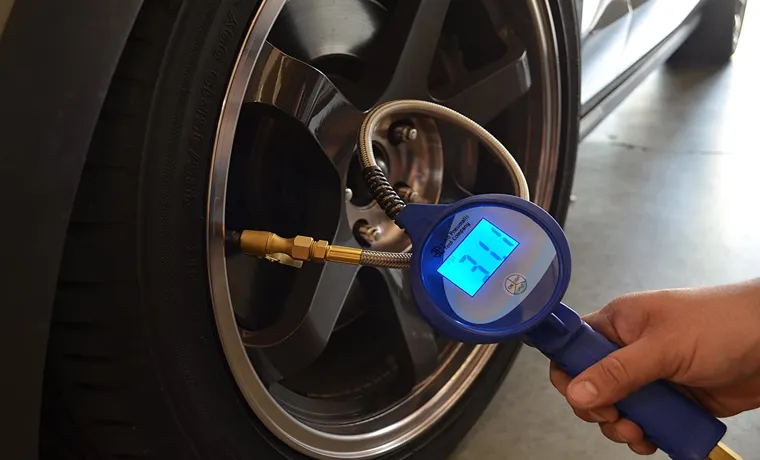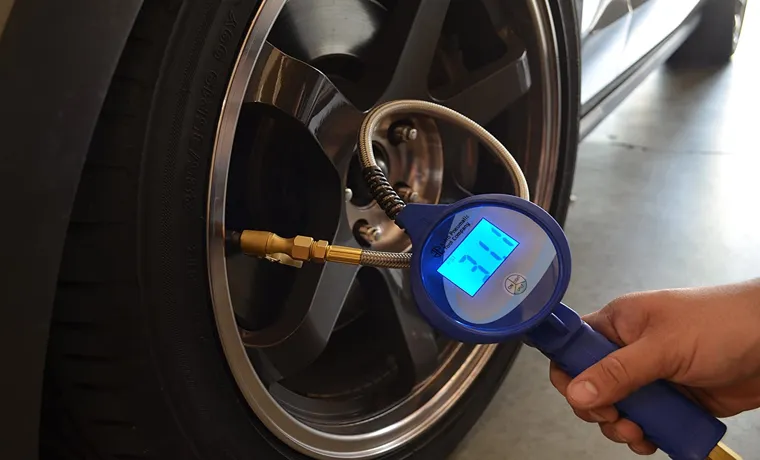Do you know how important it is to keep your tires properly inflated? Not only is it crucial for your car’s handling and fuel efficiency, but it’s also essential for your safety. The Audi Q3 is a luxury SUV that requires careful attention to tire pressure. In this blog post, we’ll show you how to check the tire pressure on your Audi Q3, so you can ensure that your car is running safely and efficiently.
Table of Contents
Why Tire Pressure is Important
Checking the tire pressure in your Audi Q3 is an essential task that should not be overlooked. It affects not only the ride quality but also your car’s handling, fuel efficiency, and safety. Low tire pressure can lead to a decrease in the car’s fuel economy, as well as wear and tear on the tires.
Additionally, insufficient air pressure can cause your Audi Q3 to handle poorly on the road, making it less responsive in emergency maneuvers. To check your tire pressure, you’ll need a tire pressure gauge, which can be purchased at any auto supply store. Simply remove the valve cap, attach the gauge to the valve stem and check the reading.
If you are uncertain of the correct tire pressure levels, look in your Audi Q3’s owner’s manual, or contact your local dealership. By checking your tire pressure regularly, you will ensure that your Audi Q3 runs at its optimal performance level and keeps you safe on the road.
Safety reasons for maintaining the correct tire pressure
Maintaining the correct tire pressure is crucial for a safe and smooth driving experience. Many people underestimate the importance of this simple task, but it can have a significant impact on your car’s performance and safety. When your tires are properly inflated, they have better grip on the road, which reduces the risk of skidding or sliding on wet or icy surfaces.
On the other hand, if your tire pressure is too low, it can increase the rolling resistance and cause your engine to work harder, which can lead to decreased fuel efficiency and premature tire wear. Additionally, overinflated tires can reduce your car’s stability and traction, especially in emergency situations like sudden braking or swerving. In short, maintaining the right tire pressure is essential to ensure your safety on the road and prolong the lifespan of your tires.
So, make sure to regularly check your tire pressure and adjust it according to the manufacturer’s recommended levels. Your safety is worth it!

Fuel efficiency benefits of maintaining the correct tire pressure
Maintaining the correct tire pressure is essential for the overall health and well-being of your car. Adequate tire pressure ensures optimal fuel efficiency, as underinflated tires can cause an increase in the car’s fuel consumption. This means that maintaining the right tire pressure can save you money on petrol over time.
Additionally, proper tire pressure can also enhance your vehicle’s tires’ durability, allowing them to last longer and provide a better driving experience. Therefore, it’s essential to inflate your tires to the manufacturer’s recommended pressure levels regularly. That way, you can be well on your way to a more fuel-efficient vehicle that saves you money in the long run.
Locating Tire Pressure Information
When it comes to checking the tire pressure on your Audi Q3, it’s important to know where to look for the information. The first place to check is your vehicle’s manual, which should give you the recommended tire pressure for your specific make and model. You can also find this information on the tire pressure label, which is usually located on the driver’s side door jamb.
Another option is to use a tire pressure gauge to measure the pressure yourself. Simply unscrew the valve cap, attach the gauge, and read the pressure display. Make sure to check all four tires and adjust the pressure as necessary.
Remember, the correct tire pressure not only ensures better fuel efficiency, but also improves the overall performance and safety of your vehicle. So take a few minutes to check your tire pressure regularly to keep your Audi Q3 running smoothly and safely on the road.
Finding the Audi Q3 owner’s manual
If you’re an Audi Q3 owner searching for where to locate tire pressure information in your owner’s manual, you’re at the right place! The tire pressure information can be found in the vehicle’s manual in the section designated for tire and vehicle loading information. This section in the manual usually contains a table that outlines the recommended tire pressure for all four tires during various driving conditions. More often than not, the recommended tire pressure for the front and rear axles of the vehicle may vary due to their different sizes, and this is clearly highlighted in the manual as well.
It is critical to maintain proper tire pressure for your Audi Q3 because it directly affects your vehicle’s overall performance and safety. Additionally, keeping correct inflation in your tires prevents excessive wear and tear, ultimately extending their lifespan. Therefore, make sure to check your owner’s manual for the recommended tire pressure for your vehicle and check your tire pressure regularly to ensure you’re maintaining safe driving conditions and prolonging your tire’s life.
Identifying correct tire pressure level for your vehicle
When it comes to ensuring optimal tire pressure for your vehicle, the first step is to locate the tire pressure information. This can typically be found in one of several places, including the owner’s manual, the driver’s side door jamb, or the inside of the gas tank door. The recommended pressure level will vary depending on the make and model of your vehicle, as well as the type of tires you have installed.
It’s important to follow the manufacturer’s guidelines and check the pressure regularly, as underinflation or overinflation can have negative effects on your vehicle’s handling and fuel efficiency. Properly inflated tires also have a longer lifespan and reduce the risk of blowouts. So take the time to find the correct tire pressure level for your vehicle, and enjoy a safer and smoother ride.
Checking Tire Pressure
If you want to ensure your Audi Q3 performs at its best, it’s crucial to keep an eye on its tire pressure regularly. Fortunately, checking the tire pressure is an easy and straightforward process that can keep you safe while driving. Look for the recommended tire pressure for your Audi Q3, which can be found in the owner’s manual or on the door jamb.
Then, remove the tire caps and attach a tire pressure gauge to the valve stem, ensuring it’s seated correctly. Finally, check the gauge reading and compare it to the recommended tire pressure. If the pressure is low, you can fill the tire to the recommended pressure using an air compressor or air pump at your local gas station.
Checking your tire pressure frequently can help maximize your fuel efficiency, prolong the tire life, and ensure your Audi Q3 remains safe to drive. So, make it a habit to check your tire pressure monthly, and enjoy a smoother, more comfortable ride on the road.
Gathering necessary tools and equipment
Checking tire pressure is an essential part of maintaining your vehicle. Before hitting the road, it is crucial to gather the necessary tools and equipment to check your tire pressure. The most common tool is a tire pressure gauge.
There are both digital and analog options available, and they are relatively affordable. You can also use an air compressor to inflate or deflate your tires as needed. It is important to note that overinflating or underinflating can cause uneven wear, affect fuel economy, and compromise your safety while driving.
It’s relatively simple to check your tire pressure, and you don’t need to be a mechanic to do it. In fact, you can do it yourself with just a few clicks of a button. By checking your tire pressure regularly, you can ensure your safety on the road and prevent significant damage to your vehicle.
Steps to check tire pressure
Checking Your Tire Pressure – A Simple Yet Vital Step in Car Maintenance Keeping a regular check on your vehicle’s tire pressure is an important aspect of maintenance that every car owner should take seriously. Ensuring that your tires are inflated to the recommended pressure levels can help improve fuel efficiency, extend the life of your tires and enhance overall safety on the road. Checking tire pressure is a relatively simple process that you can easily do on your own, with the help of a tire pressure gauge.
First, locate the tire air valve – this is typically located on the rim of the tire and marked with a cap. Remove the valve cap and attach the tire pressure gauge firmly to the valve. The gauge will display the tire pressure – compare this to the recommended pressure levels for your particular vehicle (which can be found in the car manual or on a sticker inside the driver’s door).
If the pressure is low, use an air compressor to fill the tire to the recommended level. On the other hand, if the pressure is too high, release air from the tire until it reaches the correct level. Checking your tire pressure may seem like a small task, but it can make a significant impact on your driving experience.
Keep in mind that tire pressure can fluctuate with changing temperatures, so it’s important to check it regularly to ensure optimal performance and safety.
Conclusion
In conclusion, checking your Audi Q3’s tire pressure is a simple yet crucial aspect of maintaining your vehicle’s performance and safety. Remembering to do this regularly will ensure a smoother drive, improve fuel efficiency, and prevent any blowouts on the road. So, don’t let your tire pressure go flat on you – take the time to check it out and keep your Q3 rolling smoothly!”
FAQs
What is the recommended tire pressure for an Audi Q3?
The recommended tire pressure for an Audi Q3 is usually between 32 and 35 psi.
How often should I check the tire pressure on my Audi Q3?
It is recommended to check the tire pressure on your Audi Q3 at least once a month or before long trips.
Can I check the tire pressure on my Audi Q3 without any special tools?
Yes, you can check the tire pressure on your Audi Q3 using a tire pressure gauge, which can be purchased at most auto parts stores.
What should I do if the tire pressure on my Audi Q3 is too low?
If the tire pressure on your Audi Q3 is too low, you should inflate the tires to the recommended pressure as soon as possible to avoid excessive wear and tear on the tires.
Is it dangerous to drive an Audi Q3 with low tire pressure?
Yes, driving an Audi Q3 with low tire pressure can be dangerous as it can affect the handling and braking of the vehicle.
Can I use nitrogen to inflate the tires on my Audi Q3?
Yes, you can use nitrogen to inflate the tires on your Audi Q3, which can help to maintain tire pressure and improve fuel efficiency.
What are some signs of low tire pressure on an Audi Q3?
Signs of low tire pressure on an Audi Q3 may include the TPMS light illuminating on the dashboard, uneven tire wear, or a decrease in fuel efficiency.


